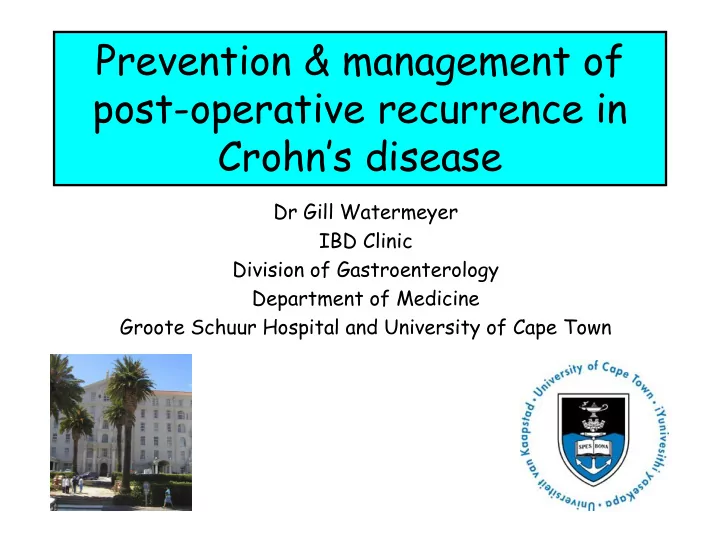

Prevention & management of post-operative recurrence in Crohn’s disease Dr Gill Watermeyer IBD Clinic Division of Gastroenterology Department of Medicine Groote Schuur Hospital and University of Cape Town
Post-operative recurrence • Very common complication of CD (almost ubiquitous) • Typically at the site of anastomosis or proximal to it Histologic Endoscopic Clinical Surgical Within 1 week 90% by 1 year 50% at 5 years 25% at 5 years
Post-operative recurrence • Early endoscopic recurrence is typically asymptomatic • Failure to treat subclinical inflammation: - May result in progressive damage - By the time symptoms occur this is often irreversible Prophylaxis Endoscopy (6-12 months) Rx based on severity Histologic Endoscopic Clinical Surgical
Prophylactic medication Histologic Endoscopic Clinical Surgical Within 1 week 90% by 1 year 50% at 5 years 25% at 5 years
Prophylaxis vs. placebo Medication Endoscopic recurrence Clinical recurrence Probiotics NS NS Budesonide NS NS 5-ASA NNT=8 NNT=12 Imidazole antibiotics NNT=4 NNT=4 AZA/6-MP NNT=4 NNT=7 Doherty G, et al. Cochrane Database Syst Rev 2009;CD006873 • Metronidazole - Effective but often poorly tolerated - Benefits disappear rapidly on discontinuation • Thiopurines - Many side effects, slow onset of action
Anti-TNFs as prophylaxis Regueiro M, et al. Gastroenterology 2009;136:441 Endoscopic recurrence at 1 year • Small numbers and in reality not as impressive • After this trial several others were published - Mostly observational (IFX and ADA) - Rates of Endoscopic POR at year ± 20%
Assess efficacy of prophylactic TNFs in preventing POR Endoscopic recurrence at week 76
Risk stratifying CD patients • Who should have immediate postoperative prophylaxis • One size does not fit all
Endoscopy guided treatment Histologic Endoscopic Clinical Surgical Within 1 week 90% by 1 year 50% at 5 years 25% at 5 years
Early endoscopy to guide therapy • Colonoscopy 6-12 months post surgery • Therapy initiated/escalated based on severity of POR і 0 і 1 і 2 і 3 і 4 “Remission” Low likelihood of progression “Recurrence” Likely to progress to another surgery Rutgeert’s score
Early endoscopy to guide therapy POCER study: 174 patients post -operatively Patients were labelled ‘high’ risk or ‘low’ risk High risk if ≥1 of the following factors: - Smoking - Perforating disease (abscess, enteric fistula) - Previous resection High risk patients received AZA/6-MP or adalimumab (if AZA/6-MP intolerant) Low risk patients received no treatment De Cruz P, et al. Lancet 2015; 385: 1406 – 17
POCER study • 50%: no endoscopy at 6/12 (standard care group) • 50%: had endoscopy at 6/12 (active care group) - Treatment escalated depending on Rutgeert’s score - Even if asymptomatic - No treatment AZA/6-MP - AZA/6-MP Adalimumab - Adalimumab Decrease dosage interval De Cruz P, et al. Lancet 2015; 385: 1406 – 17
POCER study Endoscopic recurrence at 18 months De Cruz P, et al. Lancet 2015; 385: 1406 – 17
POR in 2017 AGA Guidelines. Gastroenterology 2017;152:271 – 275
Low risk High Risk (or patient preference ) Anti-TNFs ( ± AZA/6- MP) No meds Metronidazole for 3/12 (?? metronidazole for 3/12) STOP SMOKING Colonoscopy 6-12 months *Rutgeert’s score ≥ і 2 No POR POR* Repeat Anti-TNFs and/or scope 1-3 AZA/6-MP yearly
Anti-TNFs vs. Thiopurines in POR 50 45% 45 40 35 30 Adalimumab 25 21% 20 Azathioprine 15 10 5 0 Endoscopic recurrence at 6 moths post-surgery De Cruz P, et al. Lancet 2015; 385: 1406 – 17
Low risk Intermediate High Risk (or patient preference ) risk No meds 3/12 of metronidazole 3/12 of metronidazole (?? Metronidazole) AZA/6-MP Anti-TNFs ( ± AZA/6- MP) Colonoscopy 6-12 Colonoscopy 6-12 months months * Rutgeert’s score ≥ і 2 No POR POR* POR* No POR Optimise anti- Colonoscopy Repeat TNF Anti-TNFs and/or 1-3 yearly scope 1-3 Add thiopurine AZA/6-MP yearly
Non-invasive methods to evaluate POR • Ileocolonoscopy is gold standard • But it is invasive ECCO statement 8E “Calprotectin, trans -abdominal ultrasound, MRE, and CE are emerging as alternative tools for identifying POR” Journal of Crohn's and Colitis, 2017, 135 – 149 • FC the only one ready for prime time
Faecal calprotectin • Correlates well with Rutgeert’s score • Can be used to monitor for POR and response to Rx • Predicts POR with greater accuracy than CRP/CDAI • Levels > 100 mg/g appear to be the optimal cut off - NPV 90% Wright E, et al. Gastroenterology 2015;148:938 – 947 • FC does not replace the need for colonoscopy - Rather serves as a complementary investigation - Can be measured frequently - If positive may prompt earlier endoscopy
Low risk No meds (?? Metronidazole) FC at 3/12 If +ve: earlier scope Colonoscopy 6-12 months *Rutgeert’s score ≥ і 2 No POR POR* Repeat Anti-TNFs and/or scope 1-3 AZA/6-MP yearly
The future • Personalised medicine - Tailored to the individual - Not just the fore mentioned risk factors • Predicting POR • Predicting response to therapy - Genetics - Epigenetics - Microbiome
Microbiome and POR (POCER study) • Following ileocaecal resection POR was associated with: - Elevated Proteus in the resection specimen (p = 0.01) - Reduced Faecalibacterium prausnitzii (p< 0.001) • Smokers had increased Proteus (p = 0.01) post-op Wright E, et al. Journal of Crohn's and Colitis, 2017, 191 – 203 Low Faecalibacterium High Faecalibacterium Proteus abundant Proteus absent Remission and non-smoker Recurrence and active smoker Remission and active smoker Recurrence and non- smoker
Take home messages • POR is very common • Immediate post-op prophylaxis and early Rx are key • Stratify patients by risk: STOP SMOKING • Anti-TNFs are the best therapy to date - As prophylaxis in high risk patients • Early endoscopy to guide future treatment is recommended to improve outcomes (6-12 months post-op) - Escalate Rx based on endoscopic recurrence regardless of symptoms • The future: personalised approach
Recommend
More recommend